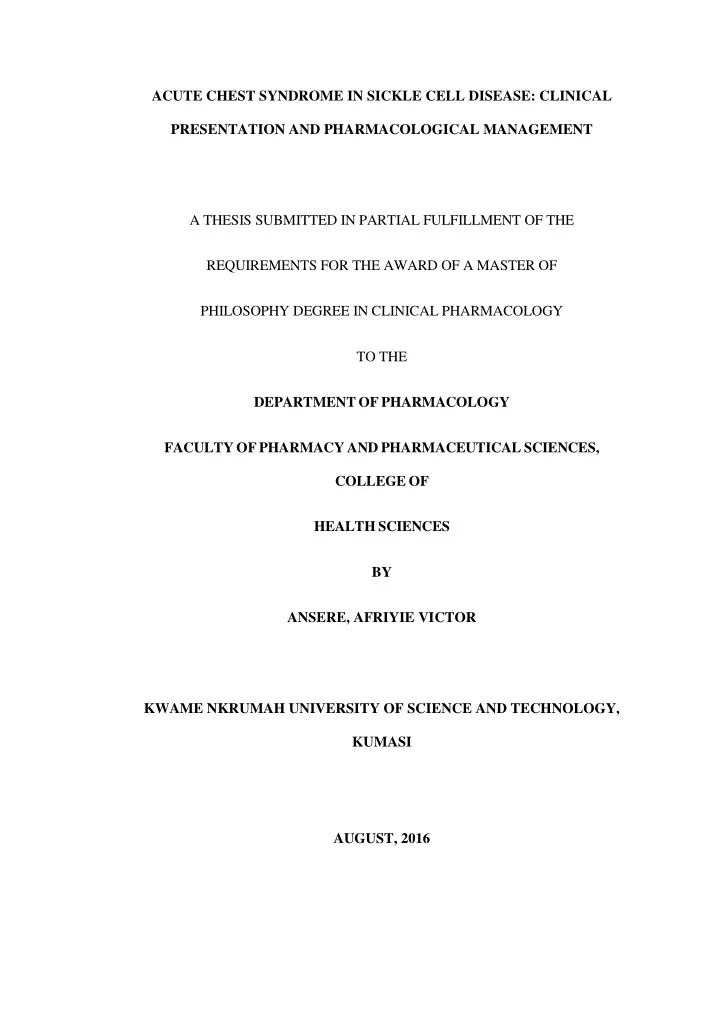

ACUTE CHEST SYNDROME IN SICKLE CELL DISEASE: CLINICAL PRESENTATION AND PHARMACOLOGICAL MANAGEMENT A THESIS SUBMITTED IN PARTIAL FULFILLMENT OF THE REQUIREMENTS FOR THE AWARD OF A MASTER OF PHILOSOPHY DEGREE IN CLINICAL PHARMACOLOGY TO THE DEPARTMENT OF PHARMACOLOGY FACULTY OF PHARMACY AND PHARMACEUTICAL SCIENCES, COLLEGE OF HEALTH SCIENCES BY ANSERE, AFRIYIE VICTOR KWAME NKRUMAH UNIVERSITY OF SCIENCE AND TECHNOLOGY, KUMASI AUGUST, 2016
DECLARATION The data collection and work described in this thesis was carried out at the Child Health Department at Komfo Anokye Teaching Hospital (KATH), and I hereby declare that this thesis is my own work and to the best of my knowledge, all references consulted have been duly cited. This work has not been submitted for a degree in any other institution of academic organization. Victor Afriyie Ansere ……………………… ………………… Student’s Name Signature Date Certified By: Dr. Kwame Ohene Buabeng ……………………… ………………… Supervisor Signature Date Certified By: Prof. Dr. David Darko Obiri ……………………… ………………… Head of Department Signature Date i
DEDICATION I dedicate this work to my family for their company, morale, concern and inspiration in varied ways. ii
ACKNOWLEDGEMENT My greatest gratitude goes to the Almighty God Jehovah; I say ―Dieu gracias‖. My sincere thanks go to Dr. Kwame Ohene Buabeng and Pharm. Dr. George A. Koffuor of the Department of Pharmacy Practice and Pharmacology respectively, KNUST, for their supervision and guidance that made this project a reality. All thanks go to Dr. Alex Osei Akoto and health professionals of the Sickle Cell Clinic of the Child Health Department of KATH and Dr. Ellis Owusu Dabo of the Kumasi Centre for Collaborative Research (KCCR) for their immense help. I am also grateful to Sandra Sekyiwaah Anane for her thoughtfulness and prayers. I also thank my friends for their support. iii
ABSTRACT Background : Acute chest syndrome (ACS) is a common cause of hospitalization and mortality in sickle cell patients across the globe. There appears to be paucity of data concerning ACS and its pharmacological management in Ghana and Africa as a whole. This study was aimed at assessing the prevalence and clinical presentation of ACS, and its pharmacotherapy in children with Sickle Cell Disease (SCD) at Komfo Anokye Teaching Hospital (KATH) in Kumasi, Ghana. Method: The designs of the study was retrospective, in which medical records of the children 14 years and below with SCD and at least an episode of ACS were retrieved and assessed at the Sickle Cell Clinic of KATH. One hundred and seven cases among 1336 children with sickle cell disease met the criteria for inclusion in the study. Results: The ages of the patients ranged from 8 months to 14 years with a mean of 5.7 ± 3.5 years. The prevalence of ACS was 8%, with a 2.2 episodes/ month rate of occurrence. Forty percent of the patients were between the ages of 5 to 9 years. Seventy five percent (n=80) presented with fever and 65% (n=70) presented with cough. Other symptoms like rhinorrhoea and irritability were common in younger patients (< 5 years), p = 0.012 and 0.001 respectively. Abdominal pain and chest pain occurred mostly in the older patients ( ≥ 5 years), p = 0.024 and < 0.001 respectively. Bacteria isolates were found in 12 of 79 cases (15.2%) that had blood culture information. Eighty four patients (80.7%) received cefuroxime and gentamicin dual therapy for empiric treatment of infection in ACS. The dose range of gentamicin used in the hospital was 3 to 9 mg/kg body weight as opposed to the recommended 5 to 7 mg/kg, as a single daily dose. The empiric antibiotic therapy for infections in ACS patients did not cover for atypical bacteria as recommended in standard guidelines. iv
Forty seven patients received paracetamol alone for pain management and 47 received paracetamol and ibuprofen. Morphine was the preferred opioid prescribed, which is in line with recommendation by WHO guidelines for pain management in SCD patients. Conclusion: The prevalence of ACS was 8%. The majority of patients were between the ages 2 to 9 years. Fever and cough were among the common clinical symptoms presented. Other clinical features like rhinorrhoea, irritability, chest pain and abdominal pain varied with age. Treatment regimen for ACS in the hospital included pharmacotherapy for infections, pain management, hydration with IV fluids and blood transfusion in patients with severe anaemia. All of these were in conformity with standard guidelines and literature. v
TABLE OF CONTENTS DECLARATION........................................................................................................... i DEDICATION.............................................................................................................. ii ACKNOWLEDGEMENT ......................................................................................... iii ABSTRACT ................................................................................................................. iv TABLE OF CONTENTS ........................................................................................... vi LIST OF TABLES ....................................................................................................... x LIST OF FIGURES .................................................................................................... xi ABBREVIATION ...................................................................................................... xii CHAPTER ONE .......................................................................................................... 1 1.0. INTRODUCTION................................................................................................. 1 1.1. GENERAL INTRODUCTION ............................................................................... 1 1.2. PROBLEM STATEMENT ..................................................................................... 2 1.3. RESEARCH QUESTIONS .................................................................................... 3 1.4. OBJECTIVES ......................................................................................................... 4 1.5. JUSTIFICATION ................................................................................................... 4 CHAPTER TWO ......................................................................................................... 6 2.0. LITERATURE REVIEW .................................................................................... 6 2.1. GENERAL INTRODUCTION ............................................................................... 6 2.2. EPIDEMIOLOGY OF ACS ................................................................................... 6 2.3. DISEASE AETIOLOGY ........................................................................................ 7 2.4. PATHOGENESIS ................................................................................................... 8 2.5. CLINICAL PRESENTATION AND DIAGNOSIS ............................................. 10 2.6. MANAGEMENT OF ACS ................................................................................... 11 2.6.1. Antibiotic use in ACS ........................................................................................ 13 vi
Recommend
More recommend